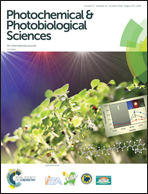The cationic dye basic orange 21 (BO21) as a potential fluorescent sensor†
Abstract
The present study investigates the fluorescence properties of BO21 and their dependence on various intracellular conditions. The results obtained with cell-free solutions indicate that the influences of pH and temperature on the fluorescence spectra are negligible, while viscosity, various proteins and heparin have significant influence. In the presence of heparin, a red shift of the emission spectrum (from 515 to 550 nm) is observed, suggesting that this shift cannot simply be attributed to electrostatic interaction between BO21 and the polyanionic heparin, but rather to aggregation of BO21 on the polyanion. In water, the quantum yield of BO21 was found to be 1000 times lower than that of fluorescein, yet surprisingly its fluorescence polarization (FP) was found to be about 40 times higher (FP = 0.470), even though both have similar structures and molecular weights. A thorough analytical and experimental investigation of these phenomena indicates that the very high FP of BO21 in water is a consequence of its very short lifetime. However, upon the addition of heparin to aqueous BO21, the fluorescence lifetime (FLT) of BO21 increases from τ = 10.35 to 56.5 ps, with a consequent dramatic drop in its fluorescence polarization from 0.470 to 0.230. From its behavior in aqueous glycerol solution, it is hypothesized, with support from theoretical calculations, that BO21 is a molecular rotor. Using these properties, BO21 may be a good candidate as a sensor, for example, of heparin levels in blood or of intracellular viscosity.



 Please wait while we load your content...
Please wait while we load your content...